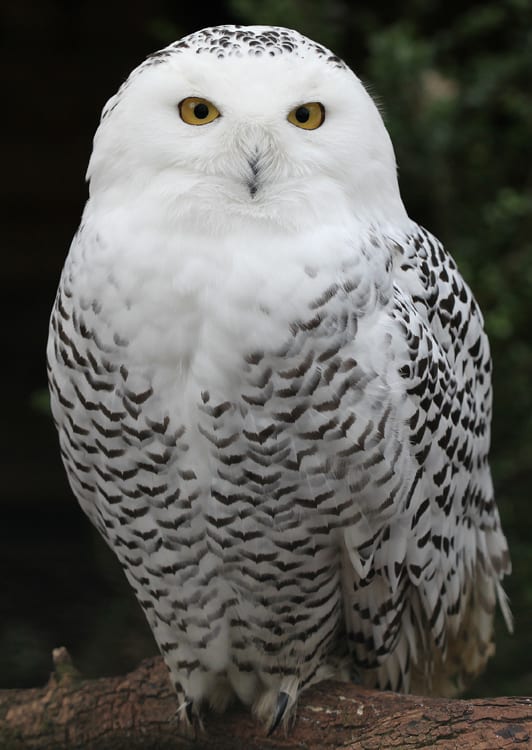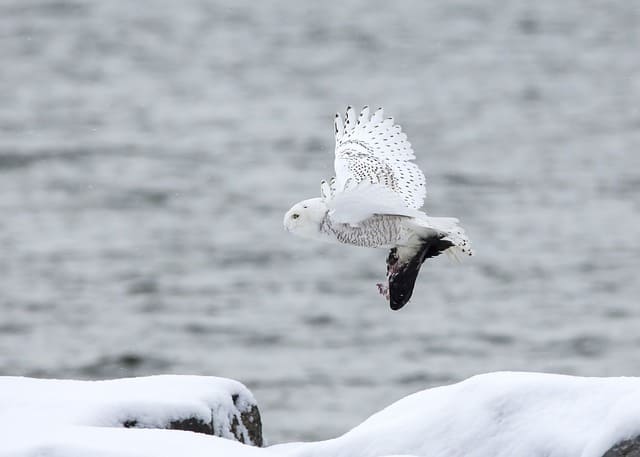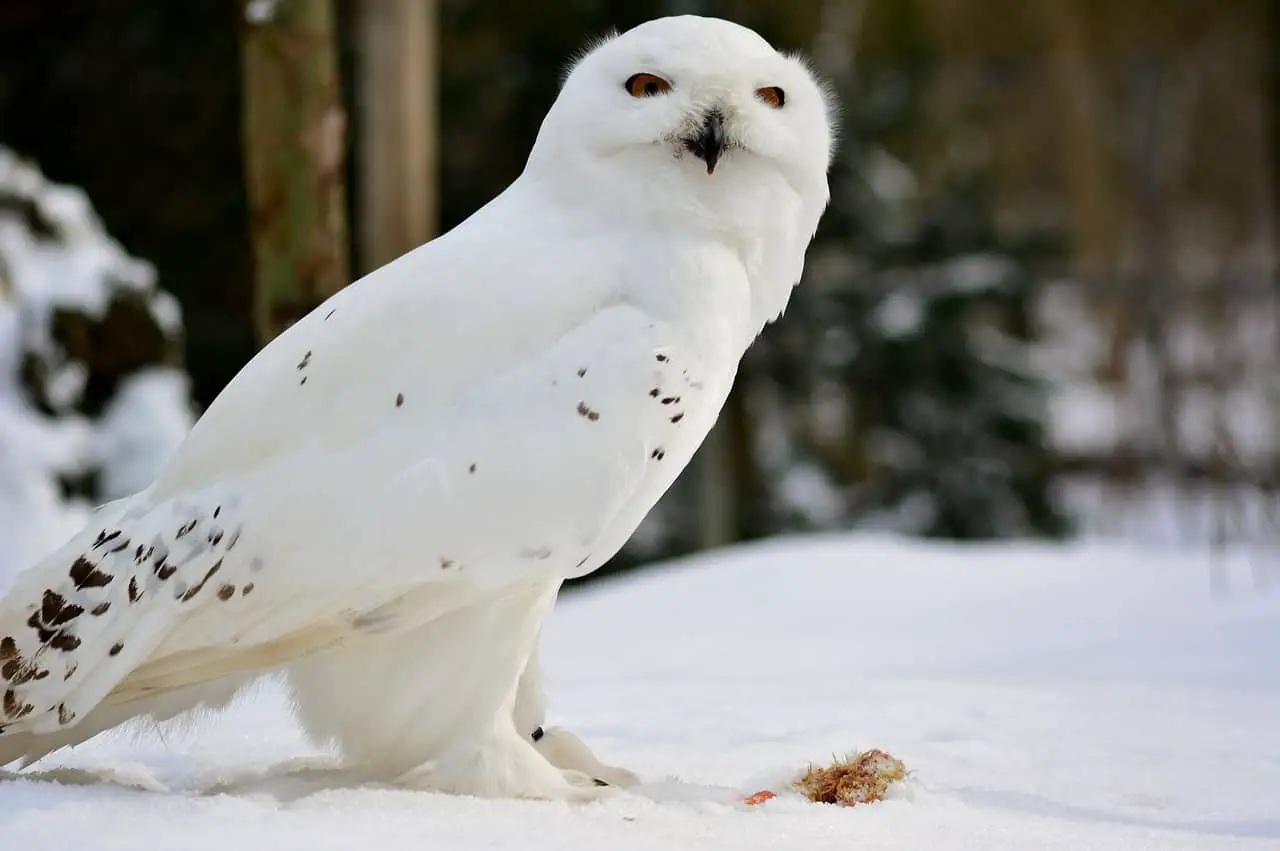Children’s books are full of fun facts about owls. Most of us would feel confident saying they have bright yellow eyes, are nocturnal, and like to hang out in barns. While this information is true for a large number of common owls, most of the things we believe we know don’t apply to the snowy owl. This magnificent bird loves open spaces, hunts a wide variety of animals, and can be spotted flying low to the ground during the middle of the day. And that’s just the tip of the iceberg when it comes to these arctic birds.
1. Snowy Owl Populations Are Effected By Lemming Populations
Snowy owls have a varied diet. They can eat small birds, small mammals, arctic hares, small rodents, and arctic foxes. However, one of their most important food sources is definitely lemmings. This is proven by the correlation between the lemming population and how many young owls were born that year. When there are lots of lemmings around, snowy owl numbers increase. When lemmings aren’t around, the snowy owls have fewer babies.
Just how many lemmings are they eating? The female snowy owls have been noticed to eat 1,600 lemmings in a good year. This averages out to four lemmings per day.
On average, female snowy owls may have a clutch of anywhere from 3-11 eggs.
2. They Live In Open Areas
Typically, when we think of owls, we imagine them perched in trees in the dead of night. We think of owls swooping through a forest, taking narrow turns high above other animals, and then diving down for their food. This isn’t the life of a snowy owl at all.
Instead, these beautiful birds love open spaces. They search out open fields, airports, and open tundra. While female snowy owls stay at the nest to take care of the young, male owls head out to hunt. They typically fly only three feet above the ground as they hunt for small prey, they can scoop up with their sharp talons.

3. Snowy Owls Build Their Nests On The Ground
These owls really do love open spaces, even for their breeding grounds. So much so that the female snowy owl builds her nest on the ground, though often on a slight hill, so she can see any oncoming prey. This often means they build their nest on top of a boulder or just a mound if that’s all that’s around.
4. They Prove That Not All Owls Are Strictly Nocturnal
As mentioned above, most of us picture owls perched on tree branches in thick forests. We can see their yellow eyes blinking in the dead of night.
Snowy owls diverge from this image in many ways, including the assumption that they are nocturnal. While they can happily live their lives in nocturnal patterns, they can also adapt to a diurnal schedule. These clever birds will vary their own activities day to day based on the available prey where they are currently living, as well as factors like the amount of sunlight. Since they tend to live very far north, where winter nights can be very long, this shift in their adaptability makes sense for them.


5. Female Snowy Owls And Adult Male Snowy Owls Do Not Look The Same
Adult males are smaller than adult females. They also have different coloring.
The adult male snowy owl can sometimes appear to have pure white plumage. They’re always the whiter of the snowy owls. While they are still large owls, they tend to weigh a maximum of four pounds.
Meanwhile, the female owl often has more of a salt-and-pepper look to her plumage, with black or brown markings down her wings. She is larger, often reaching five pounds. They can be over two feet tall, and their wingspans may reach up to six feet wide.
6. They Are The Heaviest Owl In North America
Whether you are discussing the lighter male owl or, the heavier female, these remain the heaviest owls in North America. The second heaviest owl in North America is the great horned owl, which averages a little over three pounds.
Part of what adds to the weight of this magnificent bird is its thick feathers. This serves as appropriate insulation for the arctic tundra but definitely weighs them down. In fact, their feathers even cover their legs and feet.
7. Their Scientific Name Changed In 2004
This name change actually came with some controversy within the scientific community. The snowy owl used to be known as the Nyctea scandiaca. This put them in their own genus. Then, in 2004, they were renamed to Bubo scandiacus. This happened after genetic evidence put them in the Bubo genus with horned owls. The renaming was considered controversial because some feel that the percentage of DNA that snowy owls have in common with other Bubo owls, like the great horned owl, isn’t enough to classify them this way. Still, for now, their scientific name has stuck.
8. Snowy Owls By Any Other Name
The snow owl has been known by many other names in different regions. Some of these names include the arctic owl, ghost owl, Scandinavian night bird, white terror of the north, and great white owl.

9. These Nomadic Birds Can Travel Far
The many different names we’ve given to the snowy owl indicate that these white birds like to blend into the open tundra of the arctic circle. While they are typically found in the far north of Canada and Alaska, they are actually considered nomadic birds, and they will travel far when they decide to do so. While it’s fairly common for them to come down to Southern Canada, they will sometimes head as far south as the Northern United States.
While it’s less common, during a mega-irruption period, they may travel as far as Japan. They’ve been spotted in the Caribbean, Florida, Texas, and even Hawaii. This typically happens outside of the nesting season.
10.We Can’t Truly Predict Their Irruptions
So far, what scientists know about the migration patterns of snowy owls is full of more questions than answers. It’s complex. It’s extremely interesting. What would make one snowy owl stay put in the coldest and darkest months the arctic circle experiences, while another travels all the way to Japan?
Here’s some of what we know so far. Some of the owls will stay in the same place all year. Some migrate north into the cold during the coldest months. Some will migrate a little ways south on a predictable and normal schedule.
Then, there are what we call “irruptions”. This word refers to when a large group of snowy owls migrates south, often into Southern Canada or even the Northern United States. This irruption happens every four to five years. While there have been some observations about things that happen around the time of irruptions, scientists know relatively little about why this happens.
Every few decades, something special happens. This is called a mega-irruption. When this happens, a large group of snowy owls travels much farther south than anyone can predict. It was during the mega-irruption in the winter of 2013-2014 that snowy owls were spotted in Bermuda, Florida, and other locations farther south than anyone could have predicted.
While many people believe that these mega-irruptions must happen when the snowy owls have run out of food in the north, that does not seem to be the case. The mega-irruption of the winter of 2013 followed a big summer for lemmings in Canada. That summer, the snowy owls ate a lot of lemmings, and, thus, had large clutches. It was a big nesting season with a major population boom for the snowy owls. That winter, many of the young owls were the ones that headed south. It may be that there are simply more owls when a mega-irruption happens, but scientists are still looking for more answers about the events leading to mega-irruptions.
11. Snowy Owls Are Not Monogamous
This is noteworthy because most other owl species will choose one mate for life. At this point, not enough is truly known about the mating habits of these arctic birds. What we do know is that they tend to choose one partner for the mating season, but will switch to another the next season.
We’re Still Learning More Fun Facts About Snowy Owls
The information above makes clear that we’re still studying these fascinating birds. Snowy owls stand apart as large, beautiful, nomadic hunters. Their lives are still full of secrets that scientists are uncovering as we observe the patterns of their migrations.
Recent Posts
The only venomous snakes in Washington State are Northern Pacific Rattlesnakes. The Northern Pacific Rattlesnake (Crotalus oreganus oreganus) is a sub-species of the Western Rattlesnake. Anyone...
Skunks are not classified as true hibernators. But they go into a state of torpor when the weather gets cold. Skunks are light sleep hibernators, along with opossums, bears, and raccoons. ...

